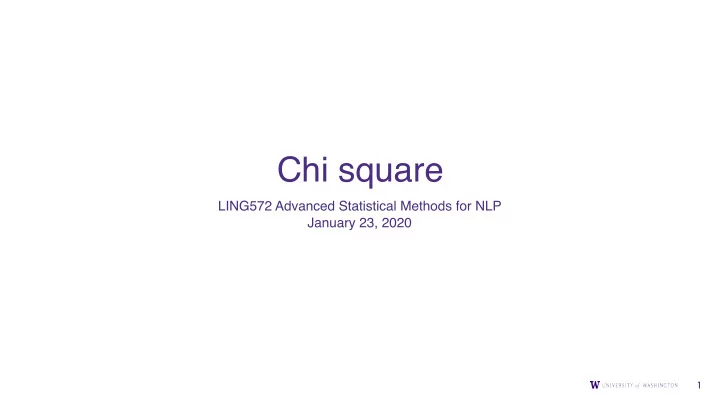

Chi square LING572 Advanced Statistical Methods for NLP January 23, 2020 1
Chi square ● An example: is having a masters degree a good feature for predicting footwear preference? ● A: MS (binary) ● B: footwear preference ● Bivariate tabular analysis: ● Is there a relationship between two random variables A and B in the data? ● How strong is the relationship? ● What is the direction of the relationship? 2
Raw frequencies Sneaker Leather Sandal Boots Others shoe MS 6 17 13 9 5 no-MS 13 5 7 16 9 Feature: has a masters degree/not Classes: {Sandal, Sneaker, ….} 3
Two distributions Sandal Sneaker Leather Boot Others Total MS 6 17 13 9 5 50 Observed distribution (O): no-MS 13 5 7 16 9 50 Total 19 22 20 25 14 100 Sandal Sneaker Leather Boot Others Total MS 50 Expected distribution (E): no-MS 50 Total 19 22 20 25 14 100 4
Two distributions Sandal Sneaker Leather Boot Others Total MS 6 17 13 9 5 50 Observed distribution (O): no-MS 13 5 7 16 9 50 Total 19 22 20 25 14 100 Sandal Sneaker Leather Boot Others Total MS 9.5 11 10 12.5 7 50 Expected distribution (E): no-MS 9.5 11 10 12.5 7 50 Total 19 22 20 25 14 100 5
Chi square ● Expected value = row total * column total / table total = P(row value) * P(column value) * table total ( O ij − E ij ) 2 χ 2 = ∑ ● E ij ij ● χ 2 = (6-9.5) 2 /9.5 + (17-11) 2 /11+ …. = 14.026 6
Calculating χ 2 ● Fill out a contingency table of the observed values ➔ O ● Compute the row totals and column totals ● Calculate expected value for each cell assuming no association ➔ E ● Compute chi square: ( O − E ) 2 / E 7
When r=2 and c=2 O = E = ( O ij − E ij ) 2 ( ad − bc ) 2 N χ 2 = ∑ = E ij ( a + b )( a + c )( b + d )( c + d ) ij 8
χ 2 test 9
Basic idea ● Null hypothesis (the tested hypothesis): no relation exists between two random variables. ● Calculate the probability of having the observation with that χ 2 value, assuming the hypothesis is true. ● If the probability is too small, reject the hypothesis. 10
Requirements ● The events are assumed to be independent and have the same distribution. ● The outcomes of each event must be mutually exclusive. ● At least 5 observations per cell. ● Collect raw frequencies, not percentages 11
Degree of freedom ● Degree of freedom df = (r – 1) (c – 1) r: # of rows c: # of columns ● In this ex: df=(2-1)(5-1)=4 12
χ 2 distribution table 0.10 0.05 0.025 0.01 0.001 1 2.706 3.841 5.024 6.635 10.828 2 4.605 5.991 7.378 9.210 13.816 3 6.251 7.815 9.348 11.345 16.266 4 7.779 9.488 11.143 13.277 18.467 5 9.236 11.070 12.833 15.086 20.515 6 10.645 12.592 14.449 16.812 22.458 … df=4 and 14.026 > 13.277 p<0.01 ➔ ➔ there is a significant relation 13
χ 2 distribution source 14
χ 2 to P Calculator http://vassarstats.net/newcs.html scipy.stats.chi2_contingency 15
Steps of χ 2 test ● Select significance level p 0 ● Calculate χ 2 ● Compute the degrees of freedom df = (r-1)(c-1) ● Calculate p given χ 2 value (or get the χ 20 for p 0 ) ● if p < p 0 (or if χ 2 > χ 20 ) then reject the null hypothesis. 16
Summary of χ 2 test ● A very common method for determining whether two random variables are independent ● Many good tutorials online ● Ex: http://en.wikipedia.org/wiki/Chi-square_distribution ● https://www.khanacademy.org/math/ap-statistics/chi-square-tests/chi-square- tests-two-way-tables/v/chi-square-test-homogeneity 17
Applying to Text Classification ● Exercise: is ‘bad’ a good feature for predicting sentiment? ● Is sentiment independent from ‘bad’ or not? ● What are counts in this table? ● Number of documents bad=1 bad=0 Total positive 13 185 negative 212 28 Total 18
Additional slides 19
χ 2 example ● Shared Task Evaluation: ● Topic Detection and Tracking (aka TDT) ● Sub-task: Topic Tracking Task ● Given a small number of exemplar documents (1-4) ● Define a topic ● Create a model that allows tracking of the topic ● I.e. find all subsequent documents on this topic ● Exemplars: 1-4 newswire articles ● 300-600 words each 20
Challenges ● Many news articles look alike ● Create a profile (feature representation) ● Find terms that are strongly associated with current topic ● Not all documents are labeled ● Only a small subset belong to topics of interest ● Differentiate from other topics AND ‘background’ 21
Approach ● X 2 feature selection: ● Assume terms have binary representation ● Positive class term occurrences from exemplar docs ● Negative class term occurrences from ● other class exemplars, ‘earlier’ uncategorized docs ● Compute X 2 for terms ● Retain terms with highest X 2 scores ● Keep top N terms ● Create one feature set per topic to be tracked 22
Tracking Approach ● Build vector space model ● Feature weighting: tf*idf ● Distance measure: Cosine similarity ● Select documents scoring above threshold ● Result: Improved retrieval 23
Recommend
More recommend